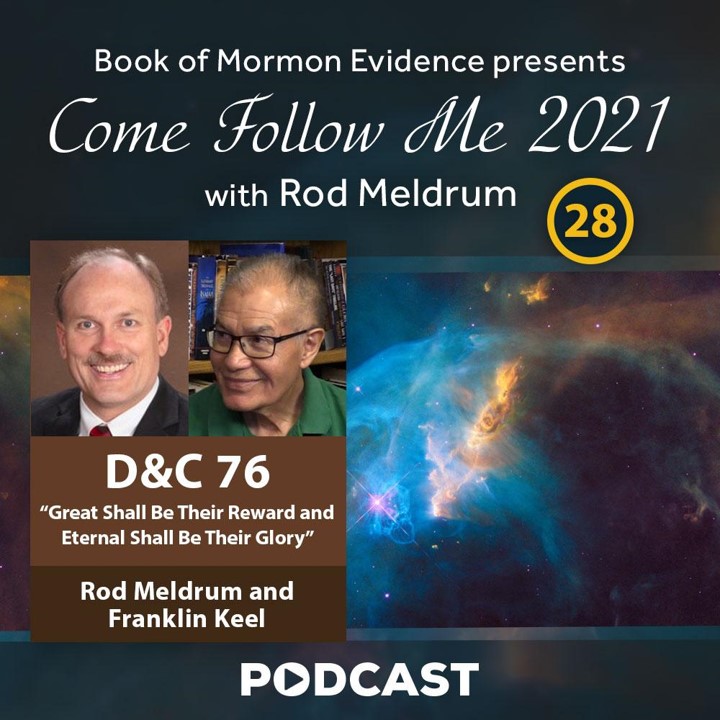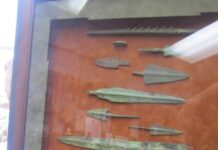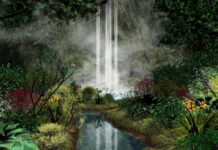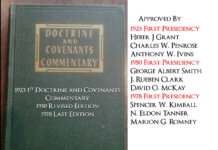
Joseph Smith: The Making of a Prophet by Dan Vogel
How Can Anyone Doubt Joseph?
“Joseph Smith claimed that the burial mounds in the region contained the bodies of destroyed Nephites when, on 4 June 1834 during a trip through Illinois with a company of Mormons, he wrote to his wife that he and others had been “wandering over the plains of the Nephites, recounting occasionally the history of the Book of Mormon, roving over the mounds of that once beloved people of the Lord, picking up their skulls and their bones, as proof of its divine authenticity.”31 The previous day Smith made an inspired declaration about a skeleton they had unearthed from an Indian burial mound, saying it was that of “Zelph”—“a white Lamanite” and “a warrior and chieftain under the great prophet Onandagus, who was known from the Hill Cumorah, or eastern sea to the Rocky mountains. … He was killed … during the last great struggle of the Lamanites and Nephites.”32

“Truly rock-ribbed faith and uncompromised conviction comes with its most complete power when it engages our head as well as our heart… Truth borne by the Holy Spirit comes with, in effect, two manifestations, two witnesses if you will—the force of fact as well as the force of feeling… I believe God intends us to find and use the evidence He has given—reasons, if you will—which affirm the truthfulness of His work…—we still need that spiritual confirmation in the heart of which we have spoken—but not to seek for and not to acknowledge intellectual, documentable support for our belief when it is available is to needlessly limit an otherwise incomparably strong theological position and deny us a unique, persuasive vocabulary in the latter-day arena of religious investigation and sectarian debate..” The Greatness of the Evidence By Elder Jeffrey R. Holland August 16, 2017
Vogel continues, “It was, in fact, in the vicinity of Manchester, New York, that the last stand of the Nephites was said to have taken place about A.D. 385, according to Smith. In 1835, under Smith’s supervision, Oliver Cowdery included in his account of early Mormon history a description of the Manchester hill from which Smith took the gold plates, including the following: “At about one mile west rises another ridge of less height, running parallel with the former … [and] between these hills, the entire power and national strength of both the Jaredites and Nephites were destroyed. … [Mormon] deposited … all the records in this same hill, Cumorah.”33 In 1842, Smith described his interviews with the angel on the hill’s summit as “Glad tidings from Cumorah!” (D&C 128:20). Similar statements from his associates indicate that Cumorah was located in western New York, not in Central America as some have suggested.34 Despite the long distance between Panama and New York, neither Smith nor his followers saw this as a problem until 1885 when the Reverend M. T. Lamb made it an issue.35 Hemispheric geography had come part and parcel with Smith’s adaptation of the mound builder myth, including the assumption that the South American and Mexican ruins were built by the same white-skinned agriculturalists who had built the earth works in North America and who destroyed by the ancestors of the Great Lakes tribes.36
Hemispheric Model

“Evidence indicates that early members of the Church did not pay a great deal of attention to Book of Mormon details about distances.[p] The “Hemispheric” or “Two-Continent” model proposes that Book of Mormon lands stretch many thousands of miles over much of South and North America. There is no first hand, verifiable statement by Joseph Smith endorsing this view. One of the earliest advocates of a hemispheric setting was the young missionary Orson Pratt, who as early as 1832 publicly promoted the idea that Lehi “crossed the water into South America”.[88] For some who read the Book of Mormon, with maps of the Western Hemisphere in view, the Isthmus of Panama seems an easy fit for the Book of Mormon’s “narrow neck of land”. Pratt claimed that the “running battle”, culminating in the destruction of the Nephite nation, started at “the Isthmus of Darien” (Panama) and “ended at Manchester” (western New York).[89] Pratt never attributed his geography (or one like it) to Joseph Smith. Pratt in fact, indicated that the South American landing idea was supposition, not revelation.[90] Pratt’s geographic views were published in the 1879 edition of the Book of Mormon, but retracted from later editions.” Hemispheric Models Wikipedia
Today not one of the maps representing all the various geography of the Book of Mormon believe in the Hemispheric Model. Not even the Mesoamericans or the Heartlanders believe the Hemispheric Model any more because the vast distance in miles make it impossible to say all of North America is where the Nephites lived and and the Lamanites lived in South America.” Editor
Letter VII
“The only thing Letter VII establishes is that Cumorah–the Cumorah of the final battles, the Cumorah of Mormon 6:6, etc.–is the hill in New York where Joseph obtained the plates.
It’s true that some contemporaries of Joseph Smith described a hemispheric model. There was quite a bit of speculation about where the Book of Mormon events took place, but zero speculation about any site for Cumorah other than New York. The 1879 Orson Pratt footnotes are a perfect example. I have a separate post on that scheduled for later this week.
It is because of this unanimous and universal understanding about the New York Cumorah that I say Cumorah is a pin in the map. It’s the touchstone between our modern world and the world of the Nephites and Jaredites. It’s the one sure thing we can rely on, and it was given to us unambiguously and definitely by Joseph and Oliver in Letter VII.” Jonathan Neville
Not Utterly Destroyed
Vogel continues, “Returning to Mormon’s account, one learns that some Nephites “dissented over unto the Lamanites” (6:15), which contradicts the previously unqualified predictions that they would be “utterly destroyed”(Mosiah 12:8; Alma 9:24; Hel. 7:24; 15:17). Later, Smith corrects this where, in dictating the replacement portion of the book, he has Lehi tell his son Joseph that his “seed shall not utterly be destroyed” (3:2-3).37
When Mormon closes his account, he reminds latter-day Indians that they are Israelites, that they must repent, and that they “must lay down [their] weapons of war, and delight no more in the shedding of blood, and take them not again, save it be that God shall command you” (7:2-4; emphasis added). Of course, the possibility that latter-day Indians might take up arms is left open, but it would be appropriate only if instructed to by God through Smith. Mormon states that he has made his record so that the Indians might more easily believe in the Bible and thereby accept the gospel of Jesus Christ (v. 9). After declaring that the Indians are “a remnant of the seed of Jacob” and of the “first covenant,” Mormon promises that it will be well with them on judgment day if they submit to baptism (v. 10). With this, his account concludes, and he turns the record over to Moroni.
“Abundant Evidence of the Truth of that which is Written in the Book”
“When…first commanded to testify of these things they [The Three Witness] demurred and told the Lord the people would not believe them for the book concerning which they were to bear record told of a people who were educated and refined, dwelling in large cities; whereas all that was then known of the early inhabitants of this country was the filthy, lazy, degraded and ignorant savages that were roaming over the land. The Lord told us, in reply that he would make it known to the people that the early inhabitants of this land had been just such a people as they were described in the book, and he would lead them to discover the ruins of great cities, and they should have abundant evidence of the truth of that which is written in the book…” – David Whitmer, Interview with James H. Hart (Richmond, Mo., 21 August 1883), as printed in Deseret Evening News, Salt Lake City, Utah as published in Annotated Book of Mormon by David Hocking and Rod Meldrum page 560.
Vogel continues, “For reasons not entirely clear, Moroni waits sixteen years before finishing the history (8:1, 6). When he finally writes, he says he intends to be brief, declaring: “I have but few things to write, which things I have been commanded by my father” (v. 1). He complains that there is little room left for writing on the plates and that he has no means of making more plates (v. 5). Yet, he continues for another fifty-five pages (first edition pages), finishing his father’s record and adding two more books: the Book of Ether, which is a history of the Jaredites, and his own book. Concerning the final battle and the death of his father, Moroni writes:
“And now it came to pass that after the great and tremendous battle at Cumorah, behold, the Nephites who had escaped into the country southward were hunted by the Lamanites, until they were all destroyed. And my father also was killed by them, and I even remain alone to write the sad tale of the destruction of my people. … And whether they will slay me, I know not. Therefore I will write and hide up the records in the earth; and whither I go it mattereth not. … I am alone … I have not friends nor whither to go. (8:2-4)
Smith may have identified with this situation. His brother Alvin had died, his family was divided over religion, former friends had become enemies, and he was living with his in-laws, who disapproved of him, as did the Methodists and others in Harmony. Smith may have become alienated from his own feelings and realized that he did not have any real connection to other people. His secret mission to save his family and the world and to assume the prophetic mantle insured that his feelings of “otherness” and “aloneness” would continue.
The remainder of Mormon’s section of the Book of Mormon (8:14-9:37) consists of Moroni’s closing exhortation, including a statement to future readers that seems well suited to those who had attempted to steal the gold plates: “The plates thereof are of no worth, because of the commandment of the Lord. For he truly saith that no one shall have them to get gain; but the record thereof is of great worth” (8:14). To those who threatened Smith with physical harm, saying “show unto me [the plates], or ye shall be smitten,” Moroni warns that there are consequences to seeking what is “forbidden of the Lord” (8:18-20).
The fact that Smith withheld the plates from public view was a point of contention in Harmony. Isaac Hale said that in that case, the plates should be removed from the house—which is to say that the box should be removed from the house—and that “if he did not, I was determined to see it.”38 Others in Harmony said that Smith promised to show them the plates and then changed his mind.39 If Smith did make any such statements, it could have been diversionary because he seemed to have had no intention of showing his enemies the plates.
Moroni describes what America will be like when the Book of Mormon appears, offering several predictions. First, “it shall come in a day when it shall be said that miracles are done away. … Yea, it shall come in a day when the power of God shall be denied, and churches become defiled and [will] be lifted up in the pride of their hearts” (8:26, 28). True, Smith lived in a day when miracles were denied by deists, skeptics, and rationalists; but it was also a time when revivalists were experiencing visions, speaking in tongues, and healing the sick. Smith likely referred to the rejection of a specific kind of miracle—the coming forth of new revelation.” Joseph Smith: The Making of a Prophet by Dan Vogel Chapter 21 Mormon and Moroni–The Final Struggle

Quotes about Cumorah’s Location and the Cave
1. “At one time a fierce battle was fought near where Buffalo, N.Y., now stands, wherein two million were lying strewn upon the earth, slain in battle and no one to bury them, till the stench drove them southward to the Hill Ramah, which was called Cumorah by the Nephite race.” Reminiscences of Joseph the Prophet, by Edward Stevensonm1893
2. “It was at this time that Mormon deposited in the Hill Cumorah all the records that had been entrusted to him except a few plates that he gave to his son Moroni. (See Mormon 6.) About A.D. 420, Moroni placed these plates with those his father, Mormon, had already deposited in the hill. (See Moroni 10:1-2.)” A Marvelous Work and a Wonder, p. 73. By LeGrand Richards
3. “This Book, which contained these things, was hid in the earth by Moroni, in a hill called by him, Cumorah, which hill is now in the State of New York, near the village of Palmyra, in Ontario County.” Autobiography of Parley P. Pratt, p. 43.
4. “[Joseph] went [into] a Cave in the Hill Comoro with Oliver Cowdry & deposited those plates upon a table or shelf. In that room were deposited a large amount of gold plates containing sacred records… Joseph Smith said that cave contained tons of choice treasures & records.” Wilford Woodruff Journal, 11 December 1869
F. “Joseph and others… went into a cave in the hill Cumorah, and saw more records than ten men could carry… There were books piled up on tables, book upon book. Those records this people will yet have, if they accept of the Book of Mormon and observe its precepts, and keep the commandments.” Heber C. Kimball
NOTES
31. Joseph Smith to Emma Smith, 4 June 1834, in Dean C. Jessee, ed., The Personal Writings of Joseph Smith, 2nd. ed. (Salt Lake City: Deseret Book Co.; Provo, UT: Brigham Young University Press, 2002), 345-46.
32. Joseph Smith Jr., History of the Church of Jesus Christ of Latter-day Saints, ed. B. H. Roberts, 7 vols., 2nd ed. rev. (Salt Lake City: Deseret Book, 1948), 2:79-80 (cf. Times and Seasons 6 [1 Jan. 1846]: 1076). Onandagus is no doubt inspired by the Onondaga Indians of central New York State. Kenneth W. Godfrey argues that those who refer to the Zelph incident as evidence against the Limited Tehuantepec Theory of Book of Mormon geography do so “on inconclusive grounds” (Kenneth W. Godfrey, “The Zelph Story,” Brigham Young University Studies 29 [Spring 1989]: 31-56). Godfrey’s oft-cited essay, however, contains many inaccuracies, not the least of which is his suggestion that Smith’s history was emended to exclude references to “the Nephites” and “the Hill Cumorah,” possibly at Smith’s instigation (47). However, these alterations were made sometime after publication of the Zelph story in the Times and Seasons in 1846 and, hence, without Smith’s participation. His assertion that “the earlier accounts do not expressly identify Zelph with the Nephites, as do the later accounts” (42) is equally false. Within months of the return of Smith and his men to Kirtland, Ohio, E. D. Howe reported that after disinterment of the bones, “Smith made a speech, prophesying or declaring that they were the remains of a celebrated General among the Nephites, mentioning his name and the battle in which he was slain, some 1500 years ago” (E. D. Howe, Mormonism Unvailed [Painesville, OH: E. D. Howe, 1834], 159). Godfrey equivocates about every key word in the Zelph accounts, but his questioning of “the plains of the Nephites” in Smith’s letter to Emma is especially strained. “Evidently these plains were in some respect associated with, or comparable to, the battlefields of the Nephites,” Godfrey argues, “but beyond this it is unclear what Joseph meant by this expression” (46). The balance of the sentence, that they were standing on the mounds of that “once beloved people of the Lord” and “picking up their skulls and their bones” as “proof” of the Book of Mormon’s “divine authenticity,” makes it abundantly clear that Smith intended “the plains of the Nephites” to be understood literally.
33. Latter Day Saints’ Messenger and Advocate 1 (July 1835): 158 (EMD 2:449).
34. One of the speculative apologists is John L. Sorenson, who has written that Cumorah was located about eighty-five miles northwest of the Isthmus of Tehuantepec in the Tuxtla Mountain chain near Tres Zapotes in south-central Veracruz (John L. Sorenson, An Ancient American Setting for the Book of Mormon [Salt Lake City: Deseret Book; and Provo, UT: FARMS, 1985], 347-50). This suggestion is problematic. Mormon describes the region around Cumorah as “a land of many waters, rivers, and fountains” (Morm. 6:4). Helaman 3:4 describes it as a land with “large bodies of water and many rivers,” stating that it is located “an exceeding great distance” into the land northward. Traditionally, these two passages of the Book of Mormon have been thought to point to the Great Lakes Region. By comparison, Tres Zapotes is not “an exceeding great distance” from the Isthmus of Tehuantepec. Some writers have proposed two lands of many waters and lakes: one the land of Cumorah—which they say is the Papaloapan Lagoon System just west of the Isthmus of Tehuantepec—the other farther west and north in the Valley of Mexico (Ibid., 267). The Book of Mormon gives no indication that such a division was implied. If this were the case, one would expect Mormon, the editor, to explicitly distinguish the area of many waters in Helaman 3:4 from the more famous “land of many waters” of Cumorah. David A. Palmer argues that “it would be fruitless to argue over how far an ‘exceeding great distance’ was to a Nephite” (In Search of Cumorah: New Evidences for the Book of Mormon from Ancient Mexico [Bountiful, UT: Horizon Publishers, 1981], 79). But if eighty-five miles or so to Tres Zapotes is “an exceeding great distance” to a Nephite, then what about the 120 miles across the Isthmus of Tehuantepec, which the Book of Mormon describes as “only the distance of a day and a half’s journey for a Nephite” (Alma 22:32)? Or what about the 155 miles from Kaminaljuyu (Nephi) to Santa Rosa (Zarahemla), spoken of as being a short distance apart? Along with the two-Cumorah theory comes the problem of explaining how the plates (not to mention the entire Nephite library) came to be in New York thousands of miles from their supposed location in Central America. (For the story of Smith, Cowdery, and others seeing the Nephite library inside the New York hill, see EMD 3:379-82.) John A. Widtsoe suggested that the plates could have been “moved from place to place by divine help” (John A. Widtsoe, “Is Book of Mormon Geography Known?” Improvement Era 53 [July 1950]: 547). But the more popular explanation is that “Moroni carried the plates by himself to the Palmyra, New York area and buried them there” (Palmer, In Search of Cumorah, 20; and Sorenson, An Ancient American Setting for the Book of Mormon, 44). This explanation is problematic because Moroni makes it clear that he buried the plates in the vicinity of the Nephites’ destruction, not 2,000 miles away in some remote region. When Moroni begins writing sixteen years after the Nephites’ destruction, we learn that he remained in the area to observe the activities of the Lamanites, at risk of being captured (Morm. 8:1-13). Uncertain about his future, Moroni buries the plates (8:3-4). When he returns twenty years later, he observes the “exceedingly fierce” wars among the Lamanites and declares: “I make not myself known to the Lamanites lest they should destroy me” (Moro. 1:1-2). After writing his final exhortation, he bids farewell: “And I seal up these records … I soon go to rest in the paradise of God” (10:2, 34). Thus, Moroni is old and ready to die when he hides the plates in the same hill around which the Nephites were destroyed. On these and other difficulties facing the new geographers, see Earl M. Wunderli, “Critique of a Limited Geography for Book of Mormon Events,”
35. See M. T. Lamb, The Golden Bible; or, The Book of Mormon. Is it from God? (Salt Lake City: Salt Lake Herald, 1885), 96-106, 205-6, 308-16. See also Vogel and Metcalfe, American Apocrypha, viii-ix.
36. See chapters 8 and 17.
37. See chapter 25.
38. “Mormonism,” Susquehanna Register, and Northern Pennsylvanian 9 (1 May 1834): 1 (EMD 4:286).
39. See the statements of Alva Hale, Nathaniel Lewis, and Joshua McKune in ibid. (EMD 4:291, 294, 325).






